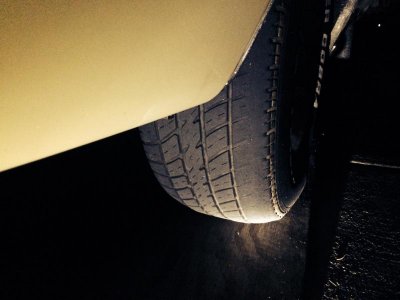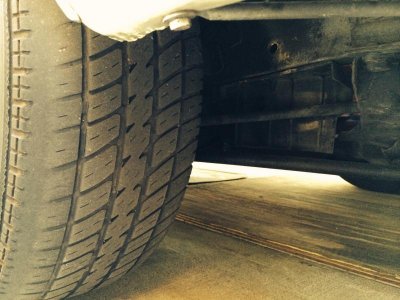 Left front tire is wearing on the outside. Just got back from a 780 mile romp. Car drives straight. As an arrow. Guesstimate is 20,000 mies on the Cooper. There is nothing like the neutral feel of a powerful rear wheel drive car. 35, 75, or 105 MPH. I am tempted to just put new Coopers on the front and not get an alignment.
Left front tire is wearing on the outside. Just got back from a 780 mile romp. Car drives straight. As an arrow. Guesstimate is 20,000 mies on the Cooper. There is nothing like the neutral feel of a powerful rear wheel drive car. 35, 75, or 105 MPH. I am tempted to just put new Coopers on the front and not get an alignment.You are using an out of date browser. It may not display this or other websites correctly.
You should upgrade or use an alternative browser.
You should upgrade or use an alternative browser.
Alignment: Tire wear vs Driveability
- Thread starter Dennis H
- Start date
miller
Well-Known Member
That's called camber.
The alignment angle, top to bottom, that sets the wheel angle. Until it's set right, the tire will continue to wear like that.
The alignment angle, top to bottom, that sets the wheel angle. Until it's set right, the tire will continue to wear like that.
khryslerkid
Well-Known Member
- Local time
- 8:02 PM
- Joined
- Mar 10, 2010
- Messages
- 32,167
- Reaction score
- 58,893
- Location
- Hanover, Pennslyvania
Put new tires on it, get it aligned and you'll get a lot more than 20k out of them. Also you think the car handles good now, wait and see how it handles with a proper alignment.
Do your homework and find an older, established shop with an alignment guy who knows these cars.
Do your homework and find an older, established shop with an alignment guy who knows these cars.
- Local time
- 7:02 PM
- Joined
- Dec 4, 2009
- Messages
- 37,689
- Reaction score
- 51,847
- Location
- Pasadena, Texas
Yup....and it can also have a bit too much toe in with too much camber.That's called camber.
The alignment angle, top to bottom, that sets the wheel angle. Until it's set right, the tire will continue to wear like that.
What's the other tire look like? If you have too much toe in, usually both front tires will wear on the outside but I'm betting that both sides have too much toe in and positive camber. I like mine with negative camber and usually a lot more than what the book calls for.
- Local time
- 5:02 PM
- Joined
- Apr 13, 2012
- Messages
- 41,939
- Reaction score
- 159,357
- Location
- Granite Bay CA
Manual steering cars, set to 1960s manual steering specs will wear like Dennis' car. They called for almost zero caster and positive camber to ease steering effort. Still, with todays tires, you can have the settings somewhere in between a P/S car and a manual and the steering effort isn't difficult. Keep in mind that modern radial tires make steering easier than with the old Bias Ply tires. The condition shown is not unusual if Dennis makes right turns often.
My Charger has Firm Feel P/S. I run 1/2 degree NEG camber, 4 degrees POS caster and 1/8" toe IN. Some people who are unfamiliar with the true effect of alignment on tire wear will tell you that any deviation from zero camber results in edge wear. NOT true. The TOE setting has far greater effect as the tires will "scrub" as they roll. Try snow skiing and see how fast you go with your tips together at the front as opposed to both skis being parallel.
I know of a good alignment shop with a "pit" but it is in the Sacramento area. These guys have never done me wrong and I've had several cars and trucks aligned there. Call if you need the contact info. Dennis, you have my number
Greg
My Charger has Firm Feel P/S. I run 1/2 degree NEG camber, 4 degrees POS caster and 1/8" toe IN. Some people who are unfamiliar with the true effect of alignment on tire wear will tell you that any deviation from zero camber results in edge wear. NOT true. The TOE setting has far greater effect as the tires will "scrub" as they roll. Try snow skiing and see how fast you go with your tips together at the front as opposed to both skis being parallel.
I know of a good alignment shop with a "pit" but it is in the Sacramento area. These guys have never done me wrong and I've had several cars and trucks aligned there. Call if you need the contact info. Dennis, you have my number
Greg
mopar 3 B
Well-Known Member
Roads were different in 1960. Very little highway mostly 2 lane. Camber was different from one side to the other to adjust for crown in roadway. Problem looks like camber and toe.
- Local time
- 5:02 PM
- Joined
- Apr 13, 2012
- Messages
- 41,939
- Reaction score
- 159,357
- Location
- Granite Bay CA
Just for fun, you could mount the fronts out back and film some great burnouts before getting new tires!
- Local time
- 7:02 PM
- Joined
- Dec 4, 2009
- Messages
- 37,689
- Reaction score
- 51,847
- Location
- Pasadena, Texas
Or dismount the tires from the rims and turn them around and wear out the other edges 
miller
Well-Known Member
Try to make sure whoever does your alignment knows to check bushings and ball joints. Real waste of time aligning, if you've got wore out parts.
Jeremiah
Well-Known Member
Looking at your pictures you probably have worn ball joints and or lower control arms. The other thing that could be causing that could be too much toe in. If you measure the toe at the front and rear of the tire it should be 1/8" (max) or 1/16" (factory) although I doubt that is the case. If the tires were had too much toe in it would show more of a "feathered" or "scrubbed" look. Whatever is going on needs to be inspected and those tires will have to be replaced.
The left front wheel leans out at the top as detected to the eye. I will dig receipts, the front end was "done about ten years ago and gives no other indications of problems. Can't believe the car drives as well and straight as it does.
- Local time
- 5:02 PM
- Joined
- Apr 13, 2012
- Messages
- 41,939
- Reaction score
- 159,357
- Location
- Granite Bay CA
The lower control arm bushings in my Charger went bad in 8000 miles. The car drove pretty straight too. I blame my own assembly procedure for the early failure: I tightened the LCA shft nut with the suspension at full droop instead of with the car resting on its tires. I learned the right way in aound 2006 after doing the full suspension rebuild in 2003.
miller
Well-Known Member
Whatever the deal is with it, all your front end stuff needs a real good check. Just part of the game, to keep all four tires on the road.
Not too many folks know what to look at these days...since they've been 'buttonized'.
Not too many folks know what to look at these days...since they've been 'buttonized'.
- Local time
- 5:02 PM
- Joined
- Apr 13, 2012
- Messages
- 41,939
- Reaction score
- 159,357
- Location
- Granite Bay CA
????????
mopar 3 B
Well-Known Member
I just do not get why some here think manual verses power steering requires different alignment requirements as Ma Mopar used same specifications for both.
383man
Well-Known Member
I just do not get why some here think manual verses power steering requires different alignment requirements as Ma Mopar used same specifications for both.
No she had some different specs back in the 60's and 70's. Manual steering usually called for less pos caster to make the car easier to steer. But the more pos caster the better the car will track. Most race cars put as much pos caster as they can in it for better high speed stability but it makes the steering wheeel harder to turn. The pos caster will also help the wheel come back to center. On my 63 with stock suspension and manual steering I give it as much pos caster as I can which is only about 1 to 2 pos as you cant get any more and keep the chamber in specs. I run my caster at about 1 to 2 pos and the camber about 0. The toe I set about 1/16 in and it works good for my street/strip car. One day I may go to aftermarket upper control arms that give more adjustment so I can get my pos caster up around 3 or 4. Ron
- Local time
- 5:02 PM
- Joined
- Apr 13, 2012
- Messages
- 41,939
- Reaction score
- 159,357
- Location
- Granite Bay CA
I just do not get why some here think manual verses power steering requires different alignment requirements as Ma Mopar used same specifications for both.
It appears that you have never read a FACTORY SERVICE MANUAL.
Similar threads
- Replies
- 74
- Views
- 9K
- Replies
- 32
- Views
- 15K
- Replies
- 7
- Views
- 3K
- Replies
- 4
- Views
- 8K

















